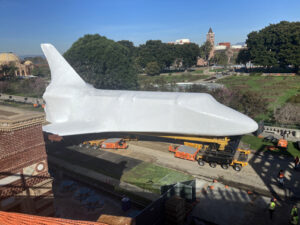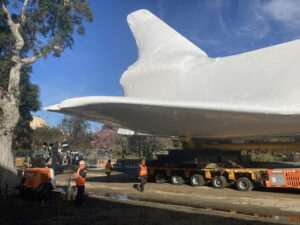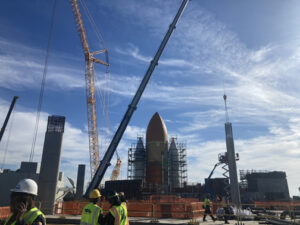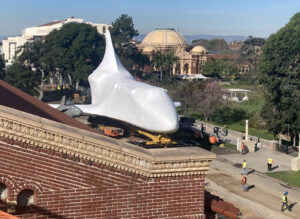
By Mikaela STONE
The California Science Center completed its space shuttle stack on Jan. 30 around 2 a.m. after its move into place on Jan. 26. Similar to the move of its fuel tank the Endeavor is now clipped to, the Go For Stack team loaded the Endeavor orbiter onto a moving platform with multi-directional wheels to roll it past the Exposition Park Rose Garden and into its crane sling. Designed to raise orbiters from horizontal to vertical positions, the sling is the only operational one of its kind in the world and has been used for every space shuttle. In spite of the crew’s need to move slower to accommodate the shuttle’s 178,000-pound mass and 78-foot wingspan, the lessons learned from the tank move two weeks prior streamlined the process so it only took two hours to complete. The moving team prepared the site by laying down steel plates to provide the shuttle the opportunity to roll up onto the sidewalk to clear trees. Despite this, the crew needed to use loppers to trim the branches that risked scraping the wings. To provide a layer of additional protection, museum volunteers had wrapped the 122-foot long and 57-foot tall at the tail orbiter in a layer of shrink wrap.

Once the wind conditions were right, a team led by three experts with 300 hours of experience in shuttle mating – the technical term for hanging the rocket on its central fuel tank – operated a roughly 420-foot crane in tandem with a smaller mobile crane to maneuver the orbiter slowly upright. Moving the upright shuttle is a slow, delicate process because crane operators cannot see the shuttle stack from their seats, forcing them to rely on directions over the radio to lift the shuttle over the already partially constructed outer wall of the future Samuel Oschin Air and Space Center. In a full circle moment, the first job of the same crane that lifted the vertical Endeavor had been to dismantle the Endeavor’s launch pad.

As the shuttle inched closer, volunteers on the scaffolding, called Sweepers, used soft broom-like tools to push the orbitor into place. Once perfectly lined up, the shuttle’s nose clipped onto a pair of phalangeal joint Bi-pod struts. The other end of the shuttle connected in two places, securing it firmly enough for launch. This sequence is identical to what the shuttle program used to prepare for takeoff when the Endeavour still flew. While the completed project looked exactly as it would in full stack, the individual components of the shuttle were assembled from piecemeal parts.

Built to replace the Challenger, the Endeavor flew 25 missions, including repairing the Hubble and bringing personnel to the International Space Station. Now it hangs atop the ET-94 tank, a flightworthy lightweight tank built for low earth orbit standalone missions. After Columbia’s tragic disaster due to foam breaking away from its fuel tank, the shuttle program changed its focus to servicing the International Space Station, which required super lightweight tanks. Because the solid rocket boosters were meant to be reusable even after the main tank had burned away, almost every piece has flown before with various shuttles with solid rocket motor segments requisitioned from a canceled project. However, to deploy the parachute that catches the boosters in the air, the shuttle’s nose cap was jettisoned and ultimately lost, requiring the museum to draw on NASA spares.
Exhibit Designer Jeremy Stoller noted how pleased he was that the California Science Center received the Endeavor among all of the other museums vying for the privilege. Ultimately, NASA decided to return the shuttle to the state that built it. He noted that the science center leaders had discussed the idea of an exhibit presenting a space shuttle in full stack for the full 30 years he has worked for them with concept drawings going back as far as 1995. The purpose of this exhibit is to inspire, educate and make space feel attainable and understandable. The aptly-named Artemis program members are currently preparing to not just land on the moon but build settlements for humans. They learn from shuttle program engineers such as Larry Clark, who passed on the lessons he learned through experience alongside the lessons taught to him by his own boss, who was an electrical engineer on the launch of the Explorer One.
As a retired director of Engineering who contracted with an array of companies from Lockheed to Normal Rockwell and worked on all 135 shuttle missions, Clark flew out from Florida each week to oversee each move and lift.
If young people can learn one thing from Clark’s years of experience, it is his advice, “Don’t be afraid to try anything new. Just go for it. Try it. Take something apart to see how it works and, for extra credit, put it back together and see how it works.”
